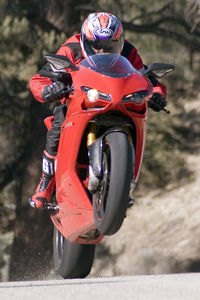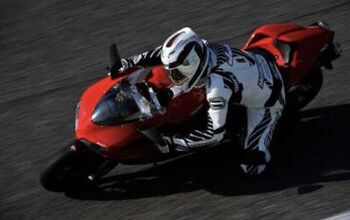Ducati 1098S - Italian Rocket Revival - Motorcycle.com
When talking about Ducati’s sportiest of machines, they’re generally seen in three different ways. 1) Lusty Italian art you can’t afford. 2) Overpriced and unreliable poser material that can’t keep up with your 50%-cheaper Gixxer Thou. 3) An inspiring amalgam of race-winning performance, high-end prestige and exotic shapes.
The truth of the matter is that each perspective has its own validity to some degree. However, the most recent iteration of Ducati’s range-topping Superbike series, the 999 model that debuted in 2003, probably had most people thinking in line with option #2, judged by its underwhelming sales numbers. While it was a better performer in every way over the previous generation 998 and its successful forebears, the Triple-9’s adventurous but blocky design failed to ignite the passion usually reserved for red Italian machines with wheels.
And so we have the new 1098, which has the notable distinctions of being faster, lighter, sexier and less expensive than 999. (It’s enough to make us sad for those who bought a 999 last year, but then again, they could probably afford the dump in resale value and there weren’t that many sold anyway…) Incredibly, the standard 1098 is a whopping $2000 cheaper than the 999.
But why have a run-of-the-mill 1098 when Ducati is offering a 1098S, the higher-spec version than includes tasty moto jewelry like Ohlins suspension, forged-aluminum wheels, a carbon fiber front fender and a data acquisition port for the extra $5000 of MSRP?
Yeah, it was an offer we couldn’t refuse, especially because we don’t have to pay for ’em (usually…).
But respectable motojournalists don’t let things like a bike’s appearance influence our entirely objective opinions. (And we’re also not interested in the incredibly hot photos of the barely clothed tight bodies you keep sending us, but we look anyway.) So, uh, yeah… We, as professionals, aren’t easily distracted. But if you water-boarded us long enough, we’d probably admit to being subjectively aroused by the Duc’s generous visual charms.
Thumb the starter and two sounds make an impression. First is the healthy bark from the twin underseat stainless steel mufflers. The 2-into-1-into-2 exhaust supposedly meets EPA specs, but it sounds more vigorous than you’d expect from federal standards. You won’t catch us complaining about the bass-heavy growl, but we did whine a bit when that same exhaust system put our buns on slow roast during warm-weather rides. The other notable sound is the suppressed jingle-jangle of clutch plates. The 1098 still uses a dry-clutch design, but it’s now quieter and easier to modulate than ever.
To make the most powerful production V-Twin engine, Ducati did a lot more than just hog out the cylinders and extend the stroke to yield the 1099cc displacement (yes, we said 1099, despite what the badge on the fairing states). The biggest change is seen in the all-new cylinder heads that are said to alone knock off a massive 6.5 lbs from the engine’s weight, which is down a total of 11 lbs from the 999 lump. A flatter combustion chamber is fed and exhausted by bigger valves to make the 104.0mm x 64.7mm mill breathe easier. MotoGP-derived elliptical Marelli throttle bodies are claimed to offer a 30% flow increase.
Add it all up and you have one of the most amazing street engines we’ve tested. It’s making more than 60 lb-ft of torque from just off idle, peaking at 7900 rpm with a wheelie-pulling 80.8 lb-ft. For those keeping track, that’s about 6 lb-ft extra twist over any of the four-cylinder literbikes. At the top end, this devilish Desmo is pumping out 141.8 horsepower, only about 5 ponies short of the winner of our Literbike Shootout, Honda’s CBR1000RR
More by Kevin Duke































Comments
Join the conversation